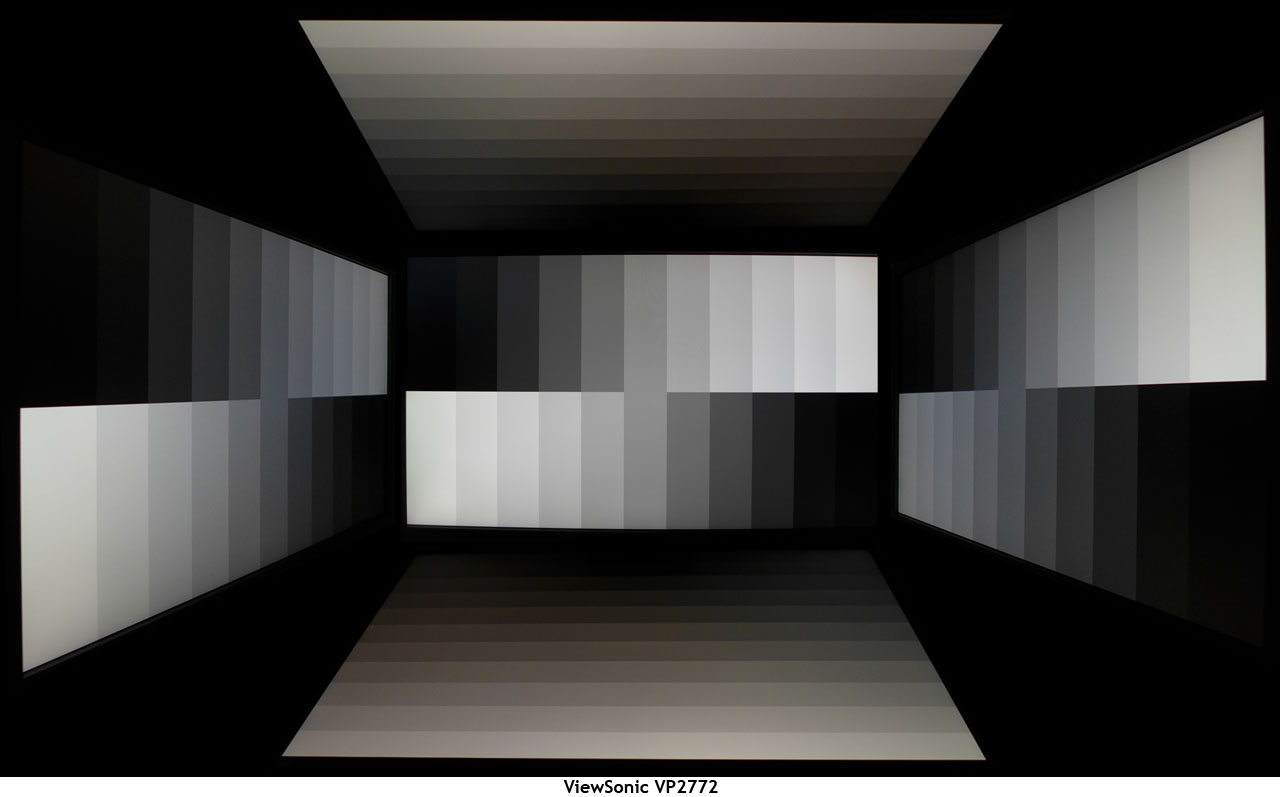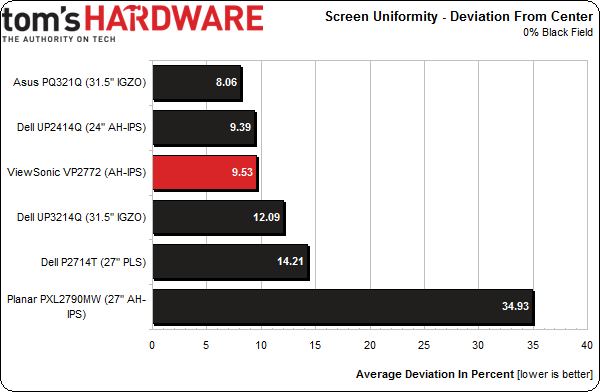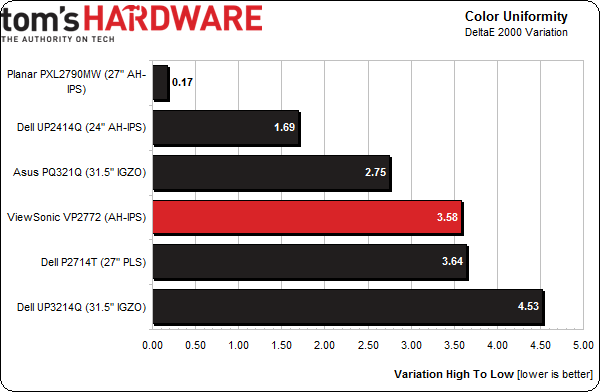ViewSonic VP2772 27-Inch QHD Professional Monitor Review
Today we’re testing the latest addition to ViewSonic's professional monitor line, the VP2772. This 27-inch screen offers QHD resolution; Adobe RGB and sRGB color gamuts; and 10-bit color with a 14-bit LUT. We see if its performance and specs match up.
Results: Viewing Angles And Uniformity
The more monitors we test, the more we can see that off-axis viewing performance is dependent not only on pixel structure (IPS, PLS, TN, etc.), but backlight technology as well. The anti-glare layer makes a difference, too.
I've reviewed two other GB-r-LED displays, Asus’ PA279Q and Dell’s UP2414Q. Both showed a distinct red shift to the sides and a subtle blue shift in the vertical plane. But ViewSonic's VP2772 has the best horizontal off-axis image I've ever seen. There is practically no light falloff and no visible color change either. Even the red tint in the top and bottom photos is minimal. You can easily see the darkest three gray bars, meaning gamma and black levels are not significantly compromised. If you’re doing color-critical work on this panel, you won’t have to lock your head to the center of the screen to maintain visual accuracy.
Screen Uniformity: Luminance
In order to gauge screen uniformity, zero- and 100-percent full-field patterns are used, and nine points are sampled. We continue comparing the results to other monitors we’ve reviewed, too.
First, we establish a baseline result at the center of each screen. Then the surrounding eight points are measured. Their values get expressed as a percentage of that the baseline figure, either above or below. This number gets averaged. It is important to remember that we only test the review sample each vendor sends us. Other examples of the same monitor may measure differently.
First up is black field uniformity.
Some professional-class displays offer uniformity compensation, but not the VP2772. We always see a reduction in contrast when it’s turned on, so that feature is not missed in today's story; the uncorrected numbers are fine by us.
Raw measurements cover a .0512 cd/m2 range from high to low, which is imperceptible. The meter does say there's a slight hotspot in the center of the screen, though.
Get Tom's Hardware's best news and in-depth reviews, straight to your inbox.
Here’s the white field measurement:
White field uniformity is also under our 10-percent standard, and we can't see any variations in tone here, either. Again, the brightest part of the panel, according to our C6 meter, is in the center.
Screen Uniformity: Color
To measure color uniformity, we display an 80-percent white field and measure the Delta E error of the same nine points on the screen. Then we subtract the lowest value from the highest to arrive at the result. A smaller number means a display is more uniform. Any value below three translates to a variation that is invisible to the naked eye.
Color uniformity from the VP2772 isn't as good as some of the other monitors we've tested. There's a faint green tint on either side of the center, and an even fainter red hue in the lower-right corner. Observing this phenomenon in actual content is difficult (a white field pattern is an extreme test). But if you are sensitive to the issue, consider finding a dealer that will let you hand-pick your monitor, since every sample will be different.
Current page: Results: Viewing Angles And Uniformity
Prev Page Results: Color Gamut And Performance Next Page Results: Pixel Response And Input Lag
Christian Eberle is a Contributing Editor for Tom's Hardware US. He's a veteran reviewer of A/V equipment, specializing in monitors. Christian began his obsession with tech when he built his first PC in 1991, a 286 running DOS 3.0 at a blazing 12MHz. In 2006, he undertook training from the Imaging Science Foundation in video calibration and testing and thus started a passion for precise imaging that persists to this day. He is also a professional musician with a degree from the New England Conservatory as a classical bassoonist which he used to good effect as a performer with the West Point Army Band from 1987 to 2013. He enjoys watching movies and listening to high-end audio in his custom-built home theater and can be seen riding trails near his home on a race-ready ICE VTX recumbent trike. Christian enjoys the endless summer in Florida where he lives with his wife and Chihuahua and plays with orchestras around the state.



